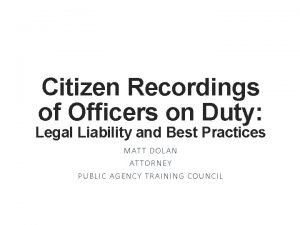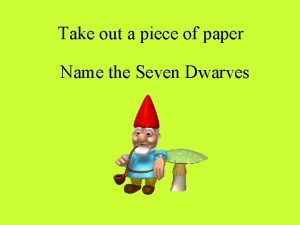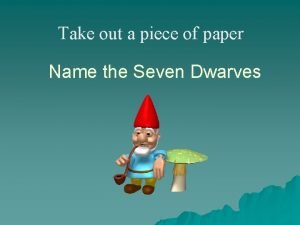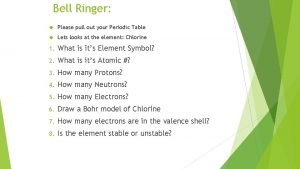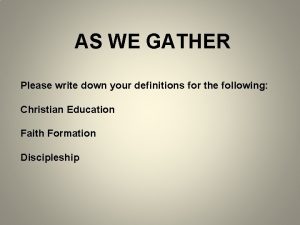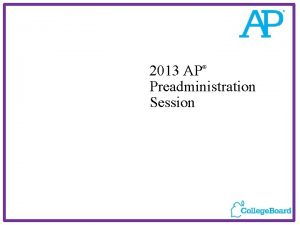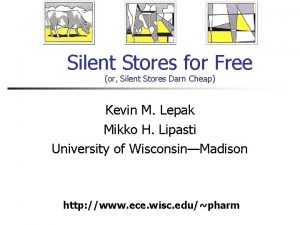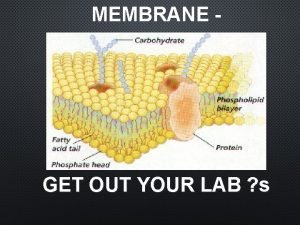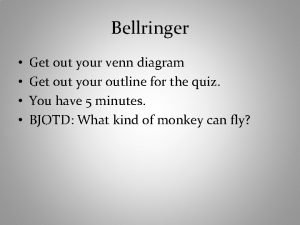Silent Free Write Please get out a piece
































- Slides: 32

Silent Free Write Please get out a piece of paper and a writing utensil.

If Ariel the Little Mermaid had evolved in different parts of the ocean…. • https: //www. buzzfeed. com/clairedelouraille/arielreimagined? utm_term=. wq. JG 4 AP 58#. cy. BY 502 qo

Peacock Spider Mating Dance • https: //www. youtube. com/watch? v=T 07 Ctdlm 7 m 4

What is a species? How do scientists determine whether two organisms are the same species or different species? When does a species stop being one species and become two species?

Speciation How one species becomes more than one species!

Species: a group of closely related organisms that are very similar to each other and are capable of interbreeding and producing fertile offspring

How do new species arise? • There are two types of speciation: • Allopatric Speciation • Sympatric Speciation

Allopatric Speciation • Speciation resulting from geographic isolation • A population is divided by a geographic barrier (i. e. , a river, a mountain range, a canyon) • The heritable traits in each of the new populations is slightly different from one another. • Over time, small variations arise and natural selection allows each population to adapt to its new environment. • Once enough time has passed, if the two populations are brought into contact, they are unable to reproduce. • Allopatric speciation has occurred.

Allopatric Speciation

Example: Kaibab and Abert’s Squirrels When the Grand Canyon formed, it split a species of squirrel into to populations. These two populations were unable to interbreed and there was no gene flow between them. Today, the Kaibab Squirrel lives on the North rim of the Grand Canyon and the Abert’s Squirrel lives on the South rim of the Grand Canyon. The two species are unable to interbreed.

Sympatric Speciation • Speciation that occurs when new species arise from an ancestral population while still occupying the same geographical area. • There are many ways this can occur!

Sympatric Speciation: Types of Isolation • Ecological Isolation: Two populations live in the same region but occupy different habitats • Example: Some lizards live in tree tops and some lizards live on the ground • Temporal Isolation: Populations that breed at different times of day/year • Example: Flowers that bloom in the spring vs flowers that bloom in the early winter cannot cross pollinate • Example: Nocturnal skunk species does not reproduce with skunks that are active during the day

Sympatric Speciation: Types of Isolation • Behavioural Isolation: Unique behavioural patterns or rituals prevent mating • Example: A bird called (no joke) the blue-footed booby has an elaborate mating dance that must be performed before mating • Mechanical Isolation: AKA “The bits don’t fit. ” Physical differences in the reproductive organs make two populations incompatible. • Example: Different kinds of flowers attract different types of pollinators and therefore do not interbreed. • Example: Different damselfly populations have differently shaped genitalia so the male and female reproductive organs don’t fit together

But what about hybrids!?

http: //www. slate. com/articles/health_and_science/sci ence/2015/06/zonkeys_ligers_the_sad_truth_about_ animal_hybrids. html • Often suffer from genetic deformities, such as dwarfism • Ligers experience unsustainable growth, which leads to their heart giving out because it cannot support their large body • Almost all hybrids are infertile, meaning they can’t pass their DNA to the next generation = very unfit

Hybrids

Models of Evolution

Models of Evolution Gradual Change Model • Species gradually accumulate small variations and changes over long periods of time • These small changes eventually result in a new species being formed Punctuated Equilibrium Model • Species are generally stable and change very little for millions of years. • Occasionally, this stability is “punctuated” by a rapid burst of change that results in a new species.

Models of Evolution

Which one do you think is correct? Gradual Change or Punctuated Equilibrium?

Types of Evolution

Divergent Evolution • The accumulation of differences between populations that can lead to the formation of new species. • Follows the idea that we are all descended from a common ancestor • Allopatric and Sympatric Speciation are both examples of divergent evolution

Evidence for Divergent Evolution • Homologous Structure: an organ or bone that appears in different organisms that suggests both organisms descended from an ancestor with similar anatomy

Adaptive Radiation • A type of divergent evolution • When an organism diversifies and adapts to a varies of different ecological niches

Classic Example: Darwin’s Finches

Adaptive Radiation: A type of divergent evolution • https: //www. youtube. com/watch? v=Pqara. WNYa. U M

Convergent Evolution • Process where organisms that are not closely related independently evolve similar traits as a result to having to adapt to similar environments or ecological niches • Can you think of some examples of convergent evolution?

Example of convergent evolution:

Australia is a weird, weird place

Co-Evolution • When two or more species influence each other’s evolution and evolve together!

Pollination and Co-Evolution • Bees are good at perceiving symmetry and the colours blue and yellow! • Therefore, flowers that use bees as pollinators will be more symmetrical and more likely to be blue or yellow • Plants prefer bees that are hairy and have the right body shape to fit into the flower • Therefore, hairy and correctly shaped bees will be more efficient at collecting nectar

Co-Evolution is everywhere! • Think about… • Predator and prey interactions! • Herbivores and plants! • Parasites and their hosts! • We’re all in this game of life together
 Shot me out of the sky you're my kryptonite meaning
Shot me out of the sky you're my kryptonite meaning Get on get off get in get out
Get on get off get in get out A piece get out of paper
A piece get out of paper Nothing is silent nothing is not silent
Nothing is silent nothing is not silent Get out of jail free card
Get out of jail free card Put attention please
Put attention please Please be quiet. i (try) to sleep
Please be quiet. i (try) to sleep Take out a piece of paper
Take out a piece of paper Take out a piece of paper
Take out a piece of paper Take out a piece of paper
Take out a piece of paper Take out a piece of paper
Take out a piece of paper Take out a piece of paper
Take out a piece of paper Take out a piece of paper
Take out a piece of paper Take out a piece of paper
Take out a piece of paper Vocabulary lesson 7
Vocabulary lesson 7 Please get ready
Please get ready Get up get moving quiz
Get up get moving quiz Get up get moving quiz
Get up get moving quiz Get up get moving
Get up get moving Pseudocode for repetition
Pseudocode for repetition Get focused get results
Get focused get results Germer
Germer Please feel free to modify
Please feel free to modify Please feel free to use it
Please feel free to use it Please feel free to interrupt me
Please feel free to interrupt me Please feel free to call us
Please feel free to call us Periodic table bell ringer
Periodic table bell ringer Please read instructions carefully before use
Please read instructions carefully before use Please take out some time
Please take out some time Please write down your name
Please write down your name What s your favourite food
What s your favourite food Please write your phone
Please write your phone Please write your name
Please write your name




